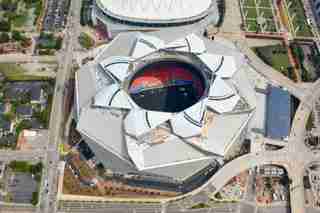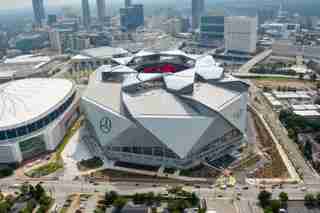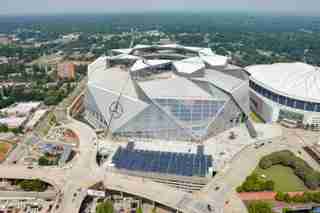July 30,2022
An Exclusive Look at the Atlanta Falcons' Brand New Stadium
by David Stewart
As we're on the eve of a brand new NFL season, it's important to consider last year's winners and losers. It was, after all, last February in the Super Bowl against the New England Patriots , that the Atlanta Falcons were painfully close to victory. In the end, however, they lost in dramatic fashion. It's incredible what eight months time can accomplish, as now, there will be no disputing the fact that the Atlanta Falcons will be at the very top of the league when it comes to having the best new stadium. Mercedes-Benz Stadium is a brand new structure that will not only seat 75,000 football fans (with a capacity to expand to 83,000), but it will do so in one of the most beautifully designed stadiums on the planet. Although the stadium will be brand new and built with some of the most advanced technologies, the initial inspiration behind its design spans back thousands of years. "I imagined a circle of light appearing over the field and growing like a spotlight, the same way the light enters the oculus of the Pantheon in Rome," says Bill Johnson, design principal for HOK, the firm responsible for designing the stadium. "From that idea grew the structure, skin, and seating bowl configuration, so all design elements supported this big idea of bringing the energy and focus to the center of the stadium through the roof’s dramatic design." Before the Falcons kick off their regular-season home schedule with a September 17 game, AD spoke with Johnson and Rich McKay, president and CEO of the Atlanta Falcons, about the innovative design process, the elements they are most proud of, and what makes this stadium stand out.

With so many innovative components to the Falcons' new stadium, it's difficult to point to one feature as being the most impressive. Yet for Johnson, it begins and ends with the roof. "The roof has captured the imagination of everyone. It opens in an unexpected and beautiful way. It’s sculptural in both the open and closed positions." Yet, according to lead designer Bill Johnson, the thought that went into designing the roof shouldn't remain only in Atlanta. The architect wants it to expand to other cities and to buildings that have nothing to do with sports. "It’s changed the conversation in the industry, and I hope [it] changes the way all sports architects think about designing retractable roofs in the future. I think the takeaway is that designers of large-scale buildings in our communities—airports, stadiums, arenas, convention centers—have to think boldly about the legacy they are leaving a city. They have to think bigger to make these traditionally utilitarian buildings have the impact that cities and communities deserve."

One glance at the Falcons' new stadium and it's easy to see it has a presence. And that's exactly what the architects at HOK were hoping to accomplish. "The exterior architecture will further enhance Atlanta’s downtown, making it a skyline that will be instantly recognizable worldwide," says Rich McKay, the team's president and CEO. But it wasn't just about the exterior: The firm wanted to create an indoor space that was second to none. "The interior design element that will set us apart is our halo board. It is a one-of-a-kind, 360-degree video board that is nearly six stories tall and 1,110 linear feet around. It hangs from the oval-shaped roof, opening just high enough that it doesn’t impede any of our fans' sight lines."

Naturally, designing a stadium that's attempting to break the mold of anything that's come before it means including some radically new, eco-friendly measures. Atlanta Falcons owner Arthur Blank "stated from the beginning he had high expectations that we would achieve the highest LEED certification possible," says lead designer Bill Johnson. "With buildings of this size, it’s imperative that they are designed and operate sustainably to minimize the impact on the environment. Water was particularly important, given that the stadium sits at the top of Proctor Creek Watershed, which is known for flooding during large storms. The building is designed to recapture and reuse rainwater with a 600,000-gallon cistern. In addition, there’s a really unique partnership with Trees Atlanta that will allow this rainwater to be used to irrigate the trees. Fans will also notice more than 4,000 solar PV panels on the stadium site."
HOK has been responsible for the design and renovation of several stadiums around the world. To that end, it was fascinating to find out what made the Mercedes-Benz Stadium stand out from those previous designs. "This project is one of a kind. . . . Everything from the unique roof geometry and mechanization to the technology used for the halo video board was fresh and new," says lead designer Bill Johnson. "The building creates a special experience for every single fan. . . . The design team measured our decisions by how we could help accomplish this goal of elevating the fan experience to new levels. . . . The stadium not only addresses . . . changing [fan] expectations but also addresses future flexibility, so as ideas and technology evolve, the building can evolve too."
The stadium's 63,800-square-foot video board is the largest in the world. And, according to the designers, the halo board was an integral part of their plans. "The story of the video board begins with the roof design," lead designer Bill Johnson says. "We had gone to great lengths to create a stadium that was open air. The stadium experience is very much 'in the round,' and it occurred to us that scoreboards in the end zones and corners weren’t compatible with that big idea. . . . So in order to stay true to the overall design idea, we had to think about the scoreboard differently."
"Upon entry and throughout their event experience, our hope is the fans will notice that this building was designed for them," says Rich McKay, the team's president and CEO. "Every design decision was made from their perspective. Whether it was the starting decision to increase the seat size from [19 to 21 inches] . . . each major design decision was based upon its impact to the fan experience instead of its potential impact to our revenue model."
HOK and the Falcons wanted to show their commitment to excellence in another area, as well, one that the fans use constantly throughout a sporting event: the concession stands. Not only will the stadium partner with local restaurants, but it will implement a few changes to the menu it believes will be a game-changer for sports and entertainment venues across the country. A few of the highlights include $2 hot dogs, unlimited-refill sodas, $3 nachos and pizza slices, and $5 beers.
We now know that a main inspiration behind the stadium's design came from the Pantheon in Rome, but Rich McKay, the team's president and CEO, argues there are certain elements in the design that truly make this structure Atlanta-centric. "One of the building’s focal points is the Window to the City [pictured]," says McKay. "This window is more than 16 stories high . . . and provides floor-to-ceiling views of Atlanta’s downtown skyline while connecting fans to the city’s landscape. . . . We did this to make sure that anyone coming to Mercedes-Benz Stadium or watching a televised event [from the stadium] would have a spectacular view of Atlanta’s skyline. That design element, along with the location of the building in the heart of downtown, makes [it] 'Atlanta-centric.'"






